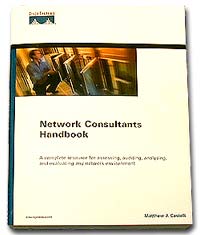Cisco Network Consultants Handbook
 Weighing
in at 970 pages, the Cisco Network Consultants Handbook covers everything from
basic networking concepts to advanced networking technologies and useful network management protocols. The Network Consultants handbook is intended to be
a one-source resource for medium to large businesses and their system administrators. As many large
networks make use of several different networking technologies like Ethernet, WLAN, Token Ring,
Fiber Distributed Data Interface (FDDI), Asynchronous Transfer Mode (ATM) LAN
Emulation, Telecomunications (ISDN, DSL, DID), Frame Relay and VoIP it is important
to have a firm grasp on each individual technology, and how they may interact.
Weighing
in at 970 pages, the Cisco Network Consultants Handbook covers everything from
basic networking concepts to advanced networking technologies and useful network management protocols. The Network Consultants handbook is intended to be
a one-source resource for medium to large businesses and their system administrators. As many large
networks make use of several different networking technologies like Ethernet, WLAN, Token Ring,
Fiber Distributed Data Interface (FDDI), Asynchronous Transfer Mode (ATM) LAN
Emulation, Telecomunications (ISDN, DSL, DID), Frame Relay and VoIP it is important
to have a firm grasp on each individual technology, and how they may interact.
In order to keep complicated networking
environments operable, and serviceable by the administrators, the Network
Consultants Handbook gives readers guidelines to work by for managing and
documenting the installations. In this regard the book moves away from a
simple guide to networking and more of real world administrative perspective. In
particular the book deals with managing all of the above networking
technologies, and even goes so far as to direct readers to review and analyse
the physical and logical topology for any type of performance inhibiting
issues.
Towards the end of the book the author delves
extensively into routing protocols and LAN/WAN assessment. From this last chapter
we can see that Cisco's Network Consultants Handbook is definitely targetting
large and multi-platform networking environments. In other words, this is not a
book for the average user, but rather a very detailed reference book for
professionals dealing with real world situations.
The book also touches briefly on IPv6 which is
the new standard for Internet Protocol. There is only one chapter dedicated
to this new topic, and it gives a good overview of routing and
addressing, address autoconfiguration, and requirements for transitioning from
the current IPv4 to IPv6.
Like the Cisco Secure PIX Firewall course book, the
Cisco Network Consultants Handbook requires some prior knowledge of
networking go get the most out of it.
For a relative newbie
to Networking, I personally gained the most from the
book in the discussions on the different LAN Transmission Topologies (from Unicast to Multicast
to Broadcast).
Chapter
14 was rather interesting because it focuses on Fiber-Optic Technology -
something which I really want to use one day.
It's amazing the amount bandwidth that Fiber Optics have; from
OC-1 (Optical Carrier) with it's 51.84 Mbps (Megabits per second) to OC-192
which has an amazing 9.953 Gbps
of bandwidth!
Cisco is targeting networking professionals with the
Network Consultants Handbook so it's not something the average Joe would pick up to read, but if you
are working in the field it could be a very useful reference book
to have on the shelf. If you have a firm grasp of networking technology
this book for you. It functions as it sounds, a handbook for Network
Consultants.
Since
this is quite a big book, the 27 Chapters are listed below
for your reference.
Chapter 1: Open System Interconnection (OSI)
Model
Chapter 2: LAN Topologies
Chapter 3: Ethernet/IEEE 802.3
Chapter 4: Ethernet Documentation
Chapter 5: Ethernet Network Review and
Analysis
Chapter 6: Token Ring/IEEE 802.5
Chapter 7: FDDI
Chapter 8: Token Ring and FDDI
Documentation
Chapter 9: Token Ring and FDDI Network Review and
Analysis
Chapter 10: ATM LAN Emulation (LANE)
Chapter 11: ATM LANE Documentation, Review and
Analysis
Chapter 12: Telecommunications and
Telephony
Chapter 13: Private Line WANs
Chapter 14: Fiber-Optic Technology
Chapter 15: Frame Relay
Chapter 16: Frame Relay Documentation
Chapter 17: Frame Relay WAN Analysis
Chapter 18: ATM Wide-Area Networking (WAN) and
MPOA
Chapter 19: ATM WAN Documentation
Chapter 20: Voice Technology
Chapter 21: Remote Access and VPNs
Chapter 22: Network Management
Introduction
Chapter 23: IP VPN WAN Documentation
Chapter 24: Routing Protocols Part I
Chapter 25: Routing Protocols Part II
Chapter 26: IPv6 Introduction
Chapter 27 Multiprotocol Label Switching
(MPLS)

